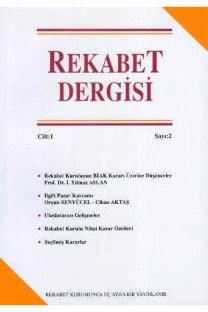Yoğunlaşmalarda yapısal tedbir mekanizması ve etkinlik değerlendirilmesi
Structural remedies in merger control and efficiency assessment
___
- Antitrust Division Policy Guide to Merger Remedies, US DOJ Antitrust Division, October 2004
- ARITÜRK R.Ö. (2008), Birleşmelerin Kontrolünde Kullanılan Esasa İlişkin Test AB Deneyimi ve Türkiye için Çıkarımlar, Yayınlanmamış Uzmanlık Tezi, Rekabet Kurumu Ankara
- CETORELLI, N. (1999), "Competitive analysis in banking: appraisal of the methodologies", Economic Perspectives, Federal Reserve Bank of Chicago, March 22, 1999
- COSNITA, A. ve J.P. TROPEANO (2009), "Negotiating Remedies: revealing the merger efficiency gains", International Journal of Industrial Organization, Elsevier, Vol. 27(2), s. 188-196
- COSNITA, A. ve J.P. TROPEANO (2008), Do Remedies Affect the Efficiency Defence? An Optimal Merger Control Analysis, http ://economix. u-parisl0.fr/docs/713/soumission-JIE.pdf, Erişim Tarihi: 11.5.2009
- COSNITA, A. ve J.P. TROPEANO (2006), "Negotiating Remedies: revealing the merger efficiency gains", EUREQua, Centre d'Economie de la Sorbonne-University Paris 1 http://haLarchives-ouvertes.fr/docs/00/19/49/06/PDF/V05047.pdf, Erişim Tarihi: 11.5.2009
- CHRISTIANSEN, A. (2000), "Regulation and EU Merger Control in the liberalised electricity sector" Philipps-University of Marburg, http://ssrn.com/abstract=870551. Erişim Tarihi: 11.5.2009
- ÇEKİNMEZ, B. (2007), "Birleşme Devralmalar: Rekabet Kurulu'nun Verdiği Şartlı İzinlerde Şartın Hukuki Niteliği ve Bu Konudaki Belirsizlikler", Rekabet Derneği Dergisi, 37. Sayısı
- DARGAUD, E. (2008), "Mergers, remedies and efficiency gains", GATE University Lyon 2, http://congres.afse.fi-/docs/775710remedies.pdf , Erişim Tarihi: 11.5.2009
- DAVIES, S. ve M. OLCZAK (2008), "Assessing the Efficacy of Structural Merger Remedies: Choosing Between Theories of Harm?", Centre for Competition Policy, University of East Anglia, CCP Working Paper 08-28
- DUSO, T., K.P. GUGLER ve B.B.YURTOĞLU (2005), "EU Merger Remedies: A Preliminary Empirical Assessment", WZB, Markets and Politics Working Paper No. SPII2005 - 16
- FARRELL, J. (2003,) "Negotiation and Merger Remedies: Some Problems", F. Lvque ve H. Shelanski (der.), Merger Remedies in American and European Union Competition Law, Edward Elgar, 2003, s.95-105
- GONZALEZ, A. (2003), "Divestitures and the Screening of Efficiency Gains in Merger Control", mimed GREMAQ http://www.economia.puc.cl/seminarios/SECHI/cursos/AGonzalez-MergerI.pdf, Erişim Tarihi: 11.5.2009
- HEYER, K. (2005), "A World of Uncertainity:Economics and Globalization of Antitrust" Antitrust Law Journal, Vol. 72 , s. 375-422
- KULAKSIZOĞLU, Ş. (2003), Rekabet Hukukunda Yatay Birleşmeler: Anti-rekabetçi Etkiler ile Öne Sürülen Savunma ve Yararlar, Rekabet Kurumu Uzmanlık Tezleri, Rekabet Kurumu, Ankara
- LEARY, T.B. (2003), "The Essential Stability of Merger Policy in United States" F. Lvque ve H. Shelanski (der.), Merger Remedies in American and European Union Competition Law, Edward Elgar, s. 13-47
- MEDVEDEV, A. (2004), "Structural Remedies in Merger Regulation in a Cournot Framework", University of East Anglia,, CCP Working Paper No. 07-16, Mtp://ssrn.com/abstract=841225 .Erişim Tarihi: 11.5.2009
- Merger Remedies Study, DG Comp European Commission, October 2005
- MOTTA, M. (2004), Competition policy: theory and practice, Cambridge University Press
- MOTTA, M., M. POLO ve H. VASCONCELOS (2003). "Merger remedies in the European Union: and overview", F. Lvque ve H. Shelanski (der.), Merger Remedies in American and European Union Competition Law , Edward Elgar, s.106-128
- NEVEN D. ve L.H. ROLLER (2000). "Consumer surplus vs. welfare standard in a political economy model of merger control", WZB discussion paper FSIV 00-15
- NEVEN , D. N., R. NUTTALL ve P. SEABRİGHT (1993), Merger in the Daylight, London CEPR
- OECD (2007), "Private Remedies", Policy Roundtables, http://www.oecd.org/dataoecd/24/62/39892177.pdf. Erişim Tarihi: 11.5.2009
- PAPANDROPOULOS, P. ve A. T AJANA (2006), "The merger remedies study-In divestiture we trust?" European Competition Law Review, 8, s. 443-454
- PERRY, M. ve R. H. PORTER (1985), "Oligopoly and the Incentive for Horizontal Merger", American Economic Review, Vol. 75(1), s. 219-227
- ROLLER L.H., J. STENNEK ve V. FRANK (2006), "Efficiency gains from mergers", F Ilzkovitz, R. Meiklejohn ve Commission of the European Communities (der.), The Efficiency Defence and the European System of Merger Control, Edward Elgar, s. 84-201
- SCHERER, F.M. (1991), Comment, Brookings Papers in Economic Activity 16
- SNELDERS, R. ve S. GENEVAZ (2007), "Merger Efficiencies and Remedies", IGLC To: Merger Control 2007, ch.2
- SHELANSKI, H.A. ve G. SIDAK (2000), "Antitrust Divestiture in Network Industries", Antitrust Divestiture in Network Industries Vol: 68, s.95-197
- ULU, H. (2004), Birleşme ve Devralmalarda Ortaya Çıkan Rekabet Sorunları Ve Koşullu İzin, Rekabet Kurumu Uzmanlık Tezleri, Rekabet Kurumu, Ankara
- VASCONCELOS, H. (2007), "Efficiency Gains and Structural Remedies in Merger Control", CEPR Discussion Paper No. DP6093. http://ssrn.com/abstract-l 132230. Erişim Tarihi: 11.5.2009
- VICKERS, J. (2005), "Abuse of Market Power ", The Economic Journal, F244-F261, 115
- WILLIAMSON O. E. (1968), Economies as An Antitrust Defense: The Welfare Tradeoffs, American Economic Review, Vol. 58(1)
- Düzenlemeler
- ABD
- U.S. Dept. of Justice, Competition and Monopoly: Single-Firm Conduct Under Section 2 of The Sherman Act (Sept. 8, 2008), http://www.usdoi. gov/atr/ public/hearings/singlefirm/ sfchearing. htm.
- Erişim Tarihi: 11.5.2009
- Antitrust Division Policy Guide to Merger Remedies, U.S. Department of Justice Antitrust Division, October 2004, http://www.usdoi.gov/atr/public/guidelines/205108.htm. Erişim Tarihi: 11.5.2009
- 1992 Horizontal Merger Guidelines, FTC ve DOJ (rev. 1997)
- http://www.usd01.g0v/atr/hmerger/l 1251 .htm, ve
- http://www.ftc.gov/bc/docs/horizmer.htm. Erişim Tarihi: 11.5.2009
- Council Regulation (EC) No 4064/89 OF 21 December 1989 on control of concentrations between undertakings, OJ L 395, 30.12.1989, OJ L 180
- Council Regulation (EC) No 139/2004 OF 20 January 2004 on control of concentrations between undertakings, OJ L 24/1
- Commission Notice on Remedies Acceptable under Council Regulation 4064/89, O J 2001 C 68/3
- Guidelines on the assessment of horizontal mergers under the Council Regulation on the control of concentrations between undertakings Official Journal C 31, 05.02.2004
- ISSN: 1302-552X
- Yayın Aralığı: 5
- Başlangıç: 2000
- Yayıncı: Rekabet Kurumu
Yoğunlaşmalarda yapısal tedbir mekanizması ve etkinlik değerlendirilmesi
Demet Şerife KAYA, Zeynep MADAN, Evren SESLİ
At komisyonu'nun yoğunlaşmalarla ilgili yeni tedbir duyurusu ışığında Türkiye açısından çıkarımlar
Birleşme ve devralma işlemlerinde rekabet kurulunun denetim yetkisinin hukuki niteliği ve sınırları
